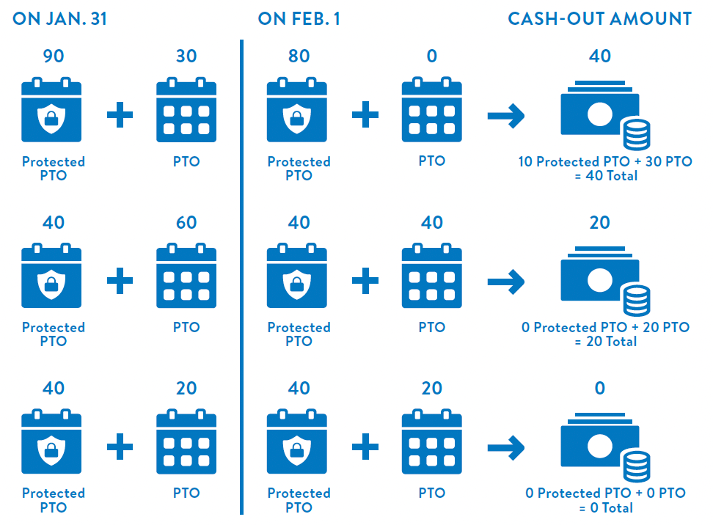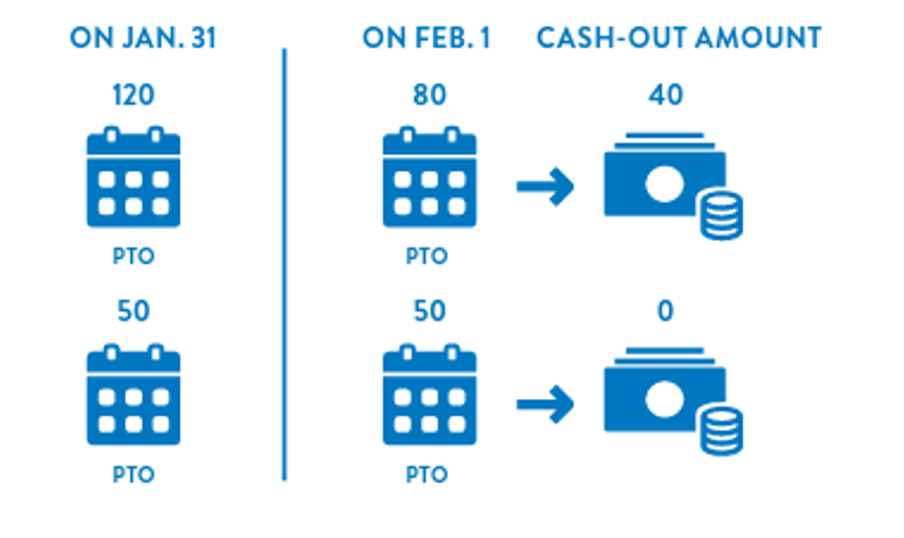Use your PTO your way.
You have flexibility and choice.
This is a modal window.
The Video Cloud account was not found.
Hourly associates
How to use PTO
First, tell your manager or supervisor as soon as possible. Then request your time off through the Global Time and Attendance (GTA) Portal. You can use your PTO for just about anything—vacations, birthdays, family time, or time for yourself. Your PTO includes time off for holidays, so you can choose the ones that are most important to you.
Keep in mind that your facility’s attendance policy still applies, so be sure to follow the process for reporting an unplanned absence.
PTO three ways.

Time when you need it
Use PTO or Protected PTO for any reason
you need to be away from work.

Unexpected needs
Use Protected PTO for sudden things
like sickness or family needs to avoid
an unexcused absence.

Cash it out, roll it over
PTO you don’t use during the year will
either roll over or turn into cash.
If you work in a field Walmart, Sam’s Club, or Supply Chain facility, you can choose to use regular PTO or Protected PTO when you enter your time off request. In Corporate/Home Office locations with access to Protected PTO, the system chooses which kind automatically depending on the reason you select. If you choose “sick/other” it’ll use Protected PTO first, while choosing any other reason will use regular PTO hours instead.
When you use Protected PTO, your absence will be authorized, even if you aren’t able to request it in advance, as long as you’ve got enough Protected PTO to cover it. If you run out and don’t have enough, your regular PTO will be used to pay the rest. But you won’t be absence-protected for the portion of your time away covered by regular PTO—so be sure to understand your facility’s attendance policy.
Because both regular PTO and Protected PTO can be used for any reason, the system will use any available PTO balance to pay you when you don’t have enough of one type or the other.
If you have a chronic or long-term medical condition, or you’re caring for a family member with one, you can request an intermittent leave of absence. You won’t receive occurrences for covered absences when you’re on an approved leave, even if you don’t use Protected PTO to get paid.
If you’re not eligible for an intermittent leave, or you’ve used up all your leave time, you may still qualify for leave as an accommodation. Call 855-489-1600 to learn more.
Didn’t use it all? Cash some out.
You can carry over up to 80 hours of your combined total of regular PTO and Protected PTO into the new plan year each Feb. 1. Any regular PTO or Protected PTO which does not carry over will be included in your paycheck for the pay period that includes Jan. 31. You can always check your balance for both kinds of PTO on the GTA Portal.
If you earn both regular and Protected PTO
Your Protected PTO will be applied first for carryover.
- If your Protected PTO balance is 80 hours or more, you will carry over 80 hours of Protected PTO. Any Protected PTO above this amount, as well as any regular PTO, will be paid out to you.
- If your Protected PTO balance is less than 80 hours, all of your Protected PTO will carry over. A portion of your regular PTO will also carry over to bring the combined total carried over up to 80 hours. The rest of your regular PTO will cash out.
- If your combined balance of Protected PTO and regular PTO is less than 80 hours on Jan. 31, both balances carry over to start the new plan year. You will not receive a cash-out.
Examples:

If you only earn regular PTO
- If your PTO balance is 80 hours or more on Jan. 31, 80 hours of your PTO carries over to start the new plan year, and any extra turns into cash.
- If your PTO balance is less than 80 hours, all of your PTO carries over to start the new plan year. You will not receive a cash-out.
Examples:

For full-time associates, your time off benefits work together to keep you covered when you need to be away for longer that your PTO will last:
- Medical. Combine PTO and short-term disability for up to 26 weeks away.
- Maternity. Get nine weeks off at 100% of your pay, after a seven-day waiting period.
- Parental. Take six weeks of paid leave to bond with a new child.
You’ll find more information under “getting paid” in the leave of absence section.
Unpaid leave
Depending on your needs and eligibility, a paid or unpaid leave of absence can cover you if you need to be away longer. Learn more about leaves of absence.
We moved from Sick Time to PTO a while back. As of Feb. 1, 2021, you don’t need to use up all your PTO and Protected PTO before you can use your leftover Sick Time. So go ahead and take that time to:
- Get medical treatment for yourself.
- Take care of a sick parent.
- Cover your pay during a medical leave that’s not covered by short-term disability benefits or during the waiting period before benefits begin.
- Cover you after short-term disability runs out if you don’t have long-term disability.
Of course, you still need to follow your facility’s attendance policy. Sick Time doesn’t work like Protected PTO. So if you use Sick Time for an unplanned absence, it may not be considered authorized.
Need to request time?
Head over to the Global Time and Attendance (GTA) Portal.
Salaried associates
How to use PTO
You can use your PTO to take time off for just about anything—vacations, birthdays, family time, or time for yourself. Your PTO includes time off for holidays, so you can choose the ones that are most important to you.
It’s important to discuss time off well in advance with your manager to keep things running smoothly while you’re away. The Salaried PTO Tracker can help you track your time off, and may be required by your division.
If you don’t use all your PTO during the year, it carries over and will be available to use the next year. A certain amount of PTO that you carry over will not affect the amount of new PTO you receive in the new plan year. But if you carry over too many days, the new plan year’s PTO will be reduced by the excess carryover. The amount you can carry over without reducing your next year’s PTO depends on where you work:
unfold_more Location Carryover
| |
|---|---|
| California | 6 days |
| Colorado | 6 days |
| Chicago/Cook County, Illinois | 8 days |
| Dallas, TX | 8 days |
| New York | 7 days |
| Saint Paul, Minnesota | 10 days |
| Seattle, WA | 13 days |
| Philadelphia, Pennsylvania | 10 days |
| Washington, D.C. | 14 days |
| All other locations | 5 days |
unfold_more Location Carryover
| California | |
|---|---|---|
unfold_more Location Carryover
| Colorado | |
unfold_more Location Carryover
| Chicago/Cook County, Illinois | |
unfold_more Location Carryover
| Dallas, TX | |
unfold_more Location Carryover
| New York | |
unfold_more Location Carryover
| Saint Paul, Minnesota | |
unfold_more Location Carryover
| Seattle, WA | |
unfold_more Location Carryover
| Philadelphia, Pennsylvania | |
unfold_more Location Carryover
| Washington, D.C. | |
unfold_more Location Carryover
| All other locations | |
For example, in most locations, if you carry over 5 days of unused PTO your new annual PTO won’t be affected. But if you carry over 8 days, your new Annual PTO will be reduced by 3 days.
For complete details see your PTO policy or ask your People Partner for details.
For full-time associates, your time off benefits work together to keep you covered when you need to be away for longer that your PTO will last:
• Medical. Combine PTO and short-term disability for up to 26 weeks away.
• Maternity. Get nine weeks off at 100% of your pay, after a seven-day waiting period.
• Parental. Take six weeks of paid leave to bond with a new child.
You’ll find more information under “getting paid” in the leave of absence section.
Unpaid leave
Depending on your needs and eligibility, a paid or unpaid leave of absence can cover you if you need to be away longer. Learn more about leaves of absence.
Let’s say you’re asked to postpone or delay your previously approved PTO due to an unforeseen business reason, such as a co-worker going on leave due to a medical emergency. You’ll want to make every effort to use that time as soon as possible. But if you can’t arrange to take it before the end of the plan year and this causes you to have excess carryover , the days you’re asked to postpone won’t reduce your new PTO for the next year.
In most locations, you’ll be paid out up to five days of earned and unused PTO if you’ve been with Walmart for at least a year. Different policies and rules apply in some state and cities. While all of your PTO is available at the beginning of the plan year, you actually earn a portion of your Annual PTO on the first day of each month, and only the unused time you’ve already earned will be considered for payout. For details, see the PTO pay when an associate leaves the company resource.
Truck driver associates
How to use PTO
First, tell your manager or supervisor as soon as possible. Then request your time off through the GTA Portal. You can use your PTO to take time off for just about anything—vacations, birthdays, family time, or time for yourself. Your PTO includes time off for holidays, so you can choose the ones that are most important to you.
Be sure to follow the process for reporting an unplanned absence. If you’re out unexpectedly for an extended period of time, your manager or People Partners can request PTO for you.
Didn’t use it all? Cash some out.
PTO you’ve saved at the end of the year can turn into cash. If you've got leftover PTO when the plan year ends on Jan 31, up to 10 days will carry over to the next year (or five days if you’re part-time). If you have more than 10 days left over, the rest will be cashed out automatically in your paycheck for the pay period that includes Jan. 31. Your PTO cash-out amount will be based on your average daily pay rate. You can always check your balance in the GTA Portal.
If you still have legacy personal days from before 2017, you can use them for any reason if you have no PTO available.
If you still have legacy sick time from before 2017, you can use them when you miss work to care for a sick family member or for your own illness, including during:
- the seven-calendar day waiting period before STD benefits begin
- an unpaid family care or medical leave of absence for which you are not eligible for STD
- an intermittent leave of absence.
You do not have to use all of your PTO before using your Sick Time.
For more information or help:
People Services: 800-421-1362
Connect with your People Partners
Visit One.Walmart.com/PTO
More resources
Downloads
Need help?
 For benefits help, call People Services at 800-421-1362.
For benefits help, call People Services at 800-421-1362.Mon.–Fri. 7 a.m.–7 p.m. (CT), Sat. 7:30 a.m.–4 p.m. (CT).






